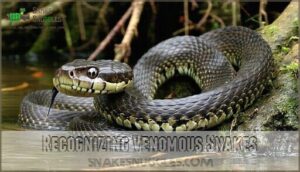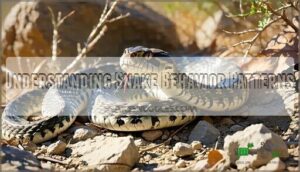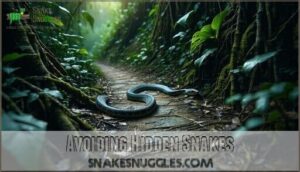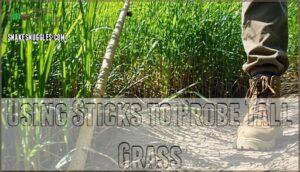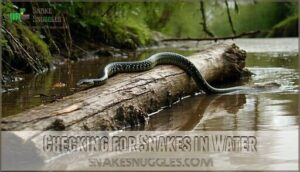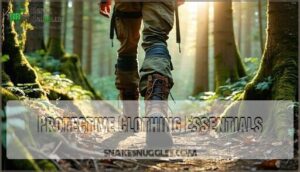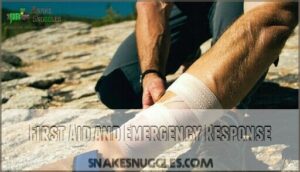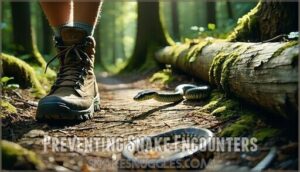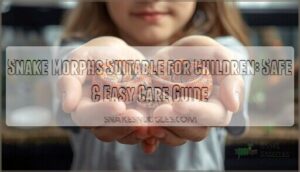This site is supported by our readers. We may earn a commission, at no cost to you, if you purchase through links.
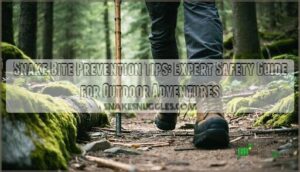
When hiking, you’ll want to steer clear of tall grass and rocky areas, and wear protective clothing like heavy boots and pants. Being mindful of your surroundings and staying on clear trails can also help to prevent snake bites.
By following these simple tips and learning more about snake behavior, you’ll be well on your way to a safe and enjoyable adventure, and there’s more to learn about staying safe from snakes, including understanding the importance of protective clothing.
Table Of Contents
- Key Takeaways
- Snake Identification Tips
- Safe Navigation Techniques
- Protective Clothing Essentials
- First Aid and Emergency Response
- Preventing Snake Encounters
- Frequently Asked Questions (FAQs)
- How to avoid snake bites?
- What should I do if a snake bites me?
- How do you stop a snake from biting your feet?
- How to protect your legs from snake bites?
- Are snake bites preventable?
- How do you deal with snakes?
- How to avoid getting bitten by snakes?
- What is the best protection against snake bites?
- What should you wear to avoid the bite of a snake?
- Can pets be trained to avoid snakes?
- Conclusion
Key Takeaways
- You’ll minimize your risk of snake bites by wearing protective clothing like heavy boots and pants, which create a barrier between your skin and potential threats.
- When hiking, you should steer clear of tall grass and rocky areas, and stay on clear trails to avoid hidden snakes, using a walking stick to probe ahead if needed.
- To prevent snake encounters, you’ll want to be mindful of your surroundings, especially near water sources, and avoid reaching into blind spots or stepping over logs without checking first.
- If you’re bitten by a snake, you should remain calm, clean the wound, elevate the limb, and seek medical care immediately, avoiding suction devices and tourniquets, to ensure proper treatment and minimize complications.
Snake Identification Tips
You’ll need to spot the difference between venomous and non-venomous snakes before you lace up your boots.
Know your snakes before hiking to stay safe and aware.
Knowing what to look for helps you stay safe and makes those woodland walks a little less nerve-racking.
Recognizing Venomous Snakes
Spotting venomous snakes starts with a close look at their head shape and markings.
Venomous head shapes are often spade-like with a broad jaw. Rattlesnake identification is easy if you hear a rattle or notice a thick, triangular head.
Copperhead patterns look like Hershey’s Kisses, while coral snake mimicry means watching for specific band colors and snake coloration.
One example is the venomous semi-aquatic snake known as the Cottonmouth.
Distinguishing Similar Species
If you’ve just brushed up on recognizing the bad actors, now let’s talk about sneaky look-alikes.
Mimicry Explained: many nonvenomous snakes copy their venomous cousins.
Don’t just trust head shape or a quick glance.
Focus on Color Variations, Pattern Recognition, and small Behavioral Differences to spot different snake species.
With over 150 examples worldwide, snake mimicry is a widespread phenomenon.
- Band color order
- Head shape tricks
- Snake patterns change by region
- Behavior during encounters
Identifying Copperheads and Rattlesnakes
When you’re learning snake identification, knowing Copperhead markings—like the Hershey Kiss shapes on their sides—gives you an edge.
Recognize Copperhead markings for a safer hike
Rattlesnakes, on the other hand, show off rattles and unique back patterns.
Juvenile identification is tricky; mimic species often copy these venomous snakes.
Copperhead snakes prefer wooded sites, while rattlesnakes frequent dry, rocky habitats, adding another clue to your toolkit.
Understanding Snake Behavior Patterns
As you venture outdoors, understanding snake behavior patterns is key.
Recognize seasonal changes, habitat preferences, and behavioral cues to avoid encounters.
Be aware of snake activity, especially in areas with preferred snake habitats, to minimize the risk of a snake encounter and stay safe.
Safe Navigation Techniques
You’re about to learn safe navigation techniques to prevent snake bites during outdoor adventures.
By following these tips, you’ll know how to avoid hidden snakes, use sticks to probe tall grass, and stay on clear trails to minimize your risk of encountering venomous snakes.
Avoiding Hidden Snakes
When hiking, you’ll want to avoid hidden snakes by staying on clear trails and being cautious near water sources, especially at night.
This is to guarantee snake safety and follow hiking safety tips, remembering to step carefully and exercise deck caution.
To avoid snakes in their habitat, it is essential to exercise deck caution and be mindful of your surroundings at all times, particularly near water sources.
Using Sticks to Probe Tall Grass
When trekking hiking trails with tall grass, use a walking stick to probe ahead, maintaining a safe distance.
Choose sturdy stick materials, considering terrain and audible warnings to enhance snake avoidance techniques, a key aspect of snake bite prevention tips.
Prior to venturing out, researching snake handling techniques is also vital for preparedness.
Staying on Clear Trails
You’re proactively avoiding snakes by using sticks in tall grass.
Now, stay on clear trails to minimize encounters.
Consider:
- Trail visibility
- Path obstacles
- Wildlife corridors
This reduces your risk of snake bites, making outdoor adventures safer with these snake avoidance techniques.
Checking for Snakes in Water
You should check for snakes in water, especially after heavy rains or in muddy areas.
| Post-Rain Caution | Drought Awareness | Water Edge Safety |
|---|---|---|
| High | Medium | Low |
| Medium | Low | High |
| Low | High | Medium |
This warning is crucial for safety.
Protective Clothing Essentials
You’re taking a vital step in preventing snake bites by learning about protective clothing essentials.
By wearing the right gear, such as heavy boots and pants, you can substantially reduce your risk of getting bitten while exploring the outdoors.
Wearing Heavy Boots and Pants
Wear heavy boots and pants for snake bite prevention.
Consider these features:
- Boot Material
- Pant Thickness
- Ankle Coverage
- Fabric Weave
- Layered Protection, ensuring protective clothing like snake proof boots and pants provide safety.
Explore options for specialized snake protection.
Choosing Thick and Durable Materials
In the context of snake bite prevention, think of clothing as your armor. Choose bite-resistant fabric with high fabric weave density and strong gaiter material strength.
Leather thickness matters for boots and gloves. Sock layering benefits add peace of mind.
You can find specialized protective gear for outdoor safety.
Here’s a quick comparison:
| Feature | What to Look For | Why It Matters |
|---|---|---|
| Fabric Weave Density | Tight, durable weave | Tougher for fangs to penetrate |
| Leather Thickness | Thick, quality leather | Extra barrier for protection |
| Gaiter Material Strength | Reinforced, reliable layers | Stops bites at the ankle |
Investing in Snake Proof Boots
High-quality snake proof boots represent your best defense against venomous bites during outdoor adventures.
Modern snake boots combine robust boot materials like full-grain leather with specialized ankle protection, creating an impenetrable barrier against fangs.
- Full-grain leather construction – Provides maximum abrasion resistance and fang penetration protection
- 16+ inch height coverage – Extends protection well above typical strike zones
- Waterproof snake barriers – Keeps feet dry while maintaining protective integrity
- Gaiter pairing compatibility – Works seamlessly with additional protective gear for enhanced coverage
These specialized boots offer superior boot lifespan compared to standard footwear, making them cost-effective for regular outdoor enthusiasts.
Kids boots are available in fitted sizes, ensuring young adventurers stay protected.
Understanding local snake species is also essential for minimizing risks.
While pricier than regular boots, snake proof boots deliver unmatched snake bite prevention through proven protective clothing technology.
Wearing Long Socks for Extra Protection
When you’re pulling on your snake proof boots, don’t forget to pay attention to your socks.
Longer, thicker socks add another layer of defense against fangs and thorns alike. Choosing the right sock material and sock length isn’t just about comfort.
Layering socks can boost sock thickness and protection. Consider adding extra thick socks for increased safety.
Remember, protective clothing works best as a team.
First Aid and Emergency Response
If you ever get bitten by a snake, knowing what to do right away can make a huge difference, so don’t panic.
Quick thinking helps you stay safe, even when your adventure takes an unexpected turn.
Treating Venomous and Non-Venomous Bites
When treating snake bites, distinguish between venomous and non-venomous bites.
Clean the wound, elevate the limb, and seek medical access.
Avoid suction devices and focus on wound cleansing and elevating the limb to reduce swelling, then get medical help for antivenom and further snake bite treatment.
Remaining Calm and Seeking Medical Care
If you’re bitten, remain calm to control panic.
Seek medical care immediately at a medical facility for antivenom access.
Immobilize the limb and avoid tourniquets.
This helps prevent further complications, ensuring proper snake bite first aid and treatment for potential snake bite symptoms during a medical emergency.
Cleaning The Bite Wound and Elevating The Limb
After remaining calm, you’ll clean the wound with gentle cleansing and antiseptic application.
Then elevate the limb to manage swelling, following proper wound cleaning steps and elevating limb properly for effective snake bite first aid and treatment.
Removing Constricting Items and Restricting Movement
When dealing with a snake bite, removing constricting items helps with Swelling Management and Circulation Safety.
Apply a loose Splint Application for Immobilization Benefits, minimizing Movement Risks.
This simple first aid step is essential in snake bite treatment, part of effective snake bite first aid and bite treatment.
Immediate action includes calling 911 promptly for rapid medical response, which is a crucial aspect of Circulation Safety.
Preventing Snake Encounters
You’re about to learn how to prevent snake encounters, a vital step in ensuring your safety during outdoor adventures.
By being mindful of your surroundings and taking a few simple precautions, you can substantially reduce your risk of a snake bite.
Being Mindful of Snake Habitats
After first aid, preventing bites is key. Being mindful of snake habitats is your first defense.
Habitat Awareness is important. Snakes love tall grass, rocky spots, and wood piles.
Climate Influence affects where they are. Streams and tree debris are Resting Spots.
Use Terrain Mapping to avoid snakeprone areas.
Seasonal Activity matters too. Increase your snake awareness!
- The fear of not seeing it.
- The surprise of a snake encounter.
- The helplessness in a snake habitat.
- The regret of not being prepared.
Avoiding Tall Grass and Rocky Areas
When hiking, avoid tall grass and rocky areas, common snake habitats.
Use trail safety and terrain mapping to steer clear.
Carry walking sticks to probe ahead, especially in limited visibility, to guarantee snake avoidance and prevention, key to snake safety tips and snake bite prevention.
You can also reduce risks by mowing grass regularly.
Staying Alert in Wooded Areas and Near Water
When near water, stay alert in wooded areas. Consider:
- Water Source Awareness
- Trail Navigation
- Avoiding Dark Spots to prevent snake encounters and bites, especially with water snakes in their habitat.
Teaching Children to Avoid Snakes and Stay Safe
When exploring outdoors with kids, teach them safe snake distances and supervised outdoor play.
Educate them on snake safety rules and age-appropriate snake education to prevent snake encounters and bites.
Ensuring emergency preparedness drills are in place.
Frequently Asked Questions (FAQs)
How to avoid snake bites?
You can avoid snake bites by wearing protective gear, staying on trails, and being cautious in wooded areas, especially near water, to minimize encounters with snakes.
What should I do if a snake bites me?
Most snake bites aren’t fatal, but you’ll need to act fast. Stay calm, call 911 immediately, and keep the bitten area below your heart while removing jewelry before swelling starts.
How do you stop a snake from biting your feet?
Wear thick, high boots and long pants when walking through snake territory.
Use a walking stick to probe ahead in tall grass or brush.
Stay on clear trails instead of stepping into areas where you can’t see your feet clearly, to minimize the risk of encountering a snake.
How to protect your legs from snake bites?
Protect your legs by wearing thick, loose-fitting pants and heavy boots that cover your ankles. These create a barrier against fangs while allowing movement through brush and tall grass safely.
Are snake bites preventable?
Like Benjamin Franklin said, "An ounce of prevention is worth a pound of cure."
Yes, you can prevent most snake bites by wearing protective gear, staying alert, and avoiding snake habitats completely, which is a key concept to prevent most issues.
How do you deal with snakes?
Stay calm and give snakes plenty of space. Back away slowly without sudden movements. Don’t attempt to catch or kill them. Most snakes flee when they sense humans approaching.
How to avoid getting bitten by snakes?
To avoid snake bites, wear thick boots and long pants when hiking.
Stick to clear trails, avoid tall grass and rocky areas.
Use a walking stick to probe ahead, and never reach into blind spots or step over logs without checking first.
What is the best protection against snake bites?
Treat heavy boots and long pants like your personal armor—slip them on before stomping through tall grass or brush.
Leather boots and thick pants block most fangs, while staying alert and keeping to clear paths makes the best shield.
What should you wear to avoid the bite of a snake?
You should wear heavy boots, long pants, and closed-toe shoes to protect yourself from snake bites, creating a barrier between your skin and potential threats.
Can pets be trained to avoid snakes?
You can train pets to avoid snakes, but it’s challenging; approximately 7,000 venomous snakebites occur annually, so consistent training is essential for their safety.
Conclusion
Considering a hike in snake country, you’ll reduce risks by following snake bite prevention tips, such as wearing protective clothing and staying on trails.
These actions are key to a safe adventure, and by remembering these snake bite prevention tips, you’ll be well-prepared.
- https://familydoctor.org/avoiding-snakebites/
- https://www.ohsu.edu/sites/default/files/2019-10/SNAKE-BITE-PREVENTION-TOOLKIT_0.pdf
- https://www.thesilverlining.com/safety-tips/snake-bite-prevention-and-treatment
- https://pubmed.ncbi.nlm.nih.gov/11990155/
- https://www.cdc.gov/niosh/outdoor-workers/about/venomous-snakes.html

